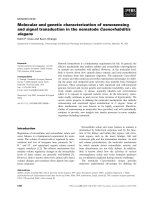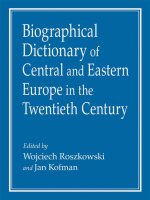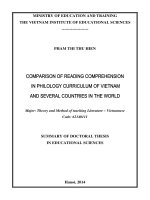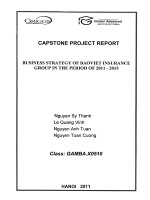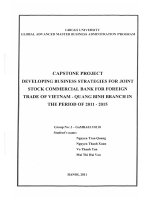Physical characterization of indoor outdoor airborne particles in the tropics
Bạn đang xem bản rút gọn của tài liệu. Xem và tải ngay bản đầy đủ của tài liệu tại đây (818.51 KB, 109 trang )
PHYSICAL CHARACTERIZATION OF INDOOR-OUTDOOR
AIRBORNE PARTICLES IN THE TROPICS
ABHISHEK GUPTA
(B. E (Hons.),Rajasthan University)
A THESIS SUBMITTED
FOR THE DEGREE OF MASTER OF SCIENCE
DEPARTMENT OF BUILDING
NATIONAL UNIVERSITY OF SINGAPORE
2004
Acknowledgements
Acknowledgements
I wish to express my profound sense of gratitude to my supervisor, Associate Professor
Kok Wai David Cheong for his valuable guidance and encouragement during the course of
research. I also thank him for his advice, comments and suggestions while analyzing the
results. His abundant and valuable research expertise helped me in completing my
research tasks successfully.
I am immensely grateful to Dr. Wong Nyuk Hien, my co–supervisor for providing me his
valuable feedback on my research work.
I am also thankful to Dr Tham Kok Wai and Dr Chandra Sekhar for their valuable
guidance and suggestions during the course of research work.
I would like to extend my thanks to Dr. A.B. Gupta, Professor, Malaviya National
Institute of Technology, India, for his constant technical feedback during the course of the
research work and for sharing his research experiences.
Most importantly, I would like to thank my parents for their unconditional love and
encouragement.
Abhishek Gupta
i
Table of Contents
Table of Contents
ACKNOWLEDGEMENTS
I
TABLE OF CONTENTS
II
SUMMARY
V
LIST OF TABLES
LIST OF FIGURES
CHAPTER 1: INTRODUCTION
VIII
IX
1
1.1 GENERAL
1
1.2 SCOPE OF WORK
1
1.3 RESEARCH OBJECTIVES
2
1.4 STRUCTURE OF THESIS
3
CHAPTER 2: LITERATURE REVIEW
5
2.1 DEFINITION
5
2.2 CHARACTERIZATION
5
2.2.1 General
5
2.2.2 Importance of particle number concentration
9
2.3 ENVIRONMENTAL IMPACTS
10
2.3.1 Health effects
10
2.3.2 Visibility impairment
15
2.3.3 Atmospheric deposition
15
2.3.4 Aesthetic damage
16
2.4 HISTORY OF AIR QUALITY STANDARDS OF PARTICLES
16
2.5 SINGAPORE AIR QUALITY
18
ii
Table of Contents
2.6 PARTICLE MIGRATION
19
2.6.1 Indoor vs. Outdoors
19
2.6.2 Role of Ambient Environment in Particle Migration
21
2.7 VERTICAL TRANSPORT OF PARTICLES IN BUILDINGS
CHAPTER 3: METHODOLOGY
22
24
3.1 INTRODUCTION
24
3.2 THEORETICAL FRAMEWORK
24
3.3 RESEARCH DESIGN
28
3.3.1 Instrumentation
29
3.3.2 Experimental Sites
38
3.3.3 Data Analysis
43
CHAPTER 4: CHARACTERIZATION OF PARTICLES
44
4.1 INTRODUCTION
44
4.2 RESULTS AND DISCUSSIONS
44
4.2.1 Weather Information
44
4.2.2 Particle Concentration
45
4.2.3 Particle Mass Vs Particle Count
49
4.2.4 Fine and Coarse Mode Particles at Outdoor Locations
51
4.3 CONCLUSIONS
52
CHAPTER 5: INDOOR - OUTDOOR (I/O) RATIO AND EFFECT OF AMBIENT
ENVIRONMENT ON I/O
55
5.1 INTRODUCTION
55
5.2 METHODOLOGY
55
5.3 RESULTS AND DISCUSSIONS
57
5.3.1 Indoor–Outdoor (I/O) Ratio
57
5.3.2 Effect of Ambient Environment on Indoor–Outdoor Ratio of Particles
60
iii
Table of Contents
5.4 CONCLUSIONS
66
5.5 LIMITATIONS
67
CHAPTER 6: PARTICLE DISTRIBUTION AT DIFFERENT HEIGHTS IN A
RESIDENTIAL BUILDING
68
6.1 INTRODUCTION
68
6.2 METHODOLOGY
68
6.3 RESULTS AND DISCUSSIONS
73
6.3.1 Particle Characterization at Different Building heights
73
6.3.2 Meteorological parameter profile at different building heights
81
6.4 CONCLUSIONS
85
CHAPTER 7: CONCLUSIONS
87
REFERENCES
90
LIST OF PUBLICATIONS
96
APPENDIX A
97
iv
Summary
Summary
Urban population is frequently exposed to high air pollution concentration, where motor
vehicle emissions constitute the main source of fine and ultra fine particles. The exposure
to particles is of concern since fine particles get deposited into the respiratory tract and can
lead to various respiratory diseases and premature deaths. The infiltration of particles into
the building will depend on the size of particle, filtration characteristics, properties of
building envelope etc.
The objective of the research is to assess the particle concentrations at indoor and outdoor
locations near major roads and to investigate the migration of particles by ascertaining I/O
ratios. The effect of ambient environmental conditions on the migration phenomenon is
also investigated. Studies have been carried out in residential apartments near major
roadways to study the particle distribution at different building heights in a multi-storey
building.
An intensive field study was carried out near one of the major expressways in Singapore
to assess the physical characteristics of particles in terms of particle mass concentration,
number concentration and particle size distribution. This study shows that –
o A significant linear correlation is observed between particle mass and particle
count.
v
Summary
o PM10 (particles less than 10 microns) comprises almost 80 % of the total suspended
particulate matter. It was observed that PM1 gravimetrically comprises 60 ± 5 % of
PM10.
o The importance of particle count is also realized. The present study shows that fine
particles comprise 99 % of the particle count. These fine particles can have severe
health implications as they have the potential to penetrate deep into the respiratory
system. Expressway is found to have higher concentration of fine particles as
compared to other locations. This is mainly attributed to the vehicle generated
combustion which is responsible for fine particles. Minor road and naturallyventilated spaces have higher concentrations of larger size particles.
o Mechanically-ventilated office space showed a lower particle concentration both in
mass and number as compared to all other locations. Particles in the coarse range
were nearly absent and this shows the high efficiency of the filtration system. The
characterization information can serve as useful criterion for filter selection.
The effects of environmental parameters like temperature, relative humidity and wind
speed on the migration of particles was investigated. Findings revealed that temperature
and wind speed have a positive influence while relative humidity has a negative influence
on the migration of particles. With the increase in particle size their dependence on
ambient parameters like temperature and relative humidity decreases significantly as
compared to wind speed. In addition, temperature may be a dominant factor governing the
migration of fine particles as compared to wind speed.
vi
Summary
This study further revealed that the concentration of particles in a building varied with
height, with first an increase in value, attains a maximum and then decreases. The
difference in concentration for PM1 was less as compared to PM10. The highest fraction of
coarse particles (PM2.5-10) out of the suspended particulate matter (PM10) is highest at the
intermediate building height. The correlation between fine and coarse mode particles at
the intermediate building height was comparatively weaker as compared to higher
building heights. It was observed that the temperature and relative humidity were highest
and wind speed was lowest at the intermediate building height.
vii
List of Tables
List of Tables
Table 2-1
Comparison of Ambient Particles, Fine Mode (nuclei mode plus
accumulation mode) and Coarse Mode
8
Table 3-1
Technical Specification of Grimm Dust Monitor (Model 1.108)
30
Table 3-2
Technical Specification of Dust Trak ( Model 8520)
31
Table 3-3
Specifications of the Weather Station
37
Table 4-1
Characterization of particles gravimetrically (µg/m3)
45
Table 4-2
Characterization on the basis of particle count (count per liter)
46
Table 4-3
Coefficient of Determination between Particle Mass and Particle
Count
51
Table 4-4
Correlation between fine and coarse mode particles
52
Table 5-1
Results of regression analysis
63
Table 5-2
Pearson Correlation between Temperature, Relative Humidity and
Wind Speed
64
Table 5-3
Pearson Correlation of I/O of different particle sizes with ambient
parameters
65
Table 6-1
Constituents of Particles
75
Table 6-2
Particle Mass vs. Particle Count
79
Table 6-3
Correlation between fine and coarse mode particles
80
viii
List of Figures
List of Figures
Figure 2-1
Hypothesis for Health effects of Particles
13
Figure 3-1
Grimm Dust Monitor
30
Figure 3-2
Dust Trak
32
Figure 3-3
Hobo meter
33
Figure 3-4
Kanomax Anemomaster
34
Figure 3-5
Location of Weather Station
35
Figure 3-6
Weather Station
36
Figure 3-7
Ayer Rajah Expressway
38
Figure 3-8
Site layout for LOC 1
39
Figure 3-9
Site layouts for LOC 2, LOC 3, and LOC 4
40
Figure 3-10
Built up section for LOC 2 and LOC 3
41
Figure 3-11
Site layout for LOC 5
43
Figure 4-1
Particle Characterization in the region 0.3 – 1.0 micron size
47
Figure 4-2
Particle Characterization in the region 1.0- 10.0 micron size
48
Figure 4-3
Particle Mass (PM10, µg/m3) and Particle Count (count per litre)
measured using Dust Trak and Grimm Dust Monitor
50
Figure 5-1
Experimental set up at outdoor location (LOC 2)
56
Figure 5-2
Experimental set up at indoor location (LOC 3)
57
Figure 5-3
Variation of I/O ratio with size range at naturally and
mechanically-ventilated spaces
58
Figure 5-4
Indoor–Outdoor ratio (I/O) at LOC 2 during morning and evening
peak traffic hours
59
Figure 5-5
Variation of I/O PM10 with Temperature
60
ix
List of Figures
Figure 5-6
Variation of I/O PM10 with RH
61
Figure 5-7
Variation of I/O PM10 with Wind Speed
62
Figure 6-1
Photograph of Building Block
70
Figure 6-2
Experimental Set up inside the Deck
70
Figure 6-3
Photograph of the Bus stop
71
Figure 6-4
Experimental setup at the Bus stop
71
Figure 6-5
Sectional details of the corridor in Building
72
Figure 6-6
Mass Distribution at different points
75
Figure 6-7(a)
Particle Characterization at Bus stop, Deck, Level 6 and Level 11
76
Figure6-7(b)
Particle Characterization at Bus stop, Deck, Level 6 and Level 11
76
Figure 6-8 (a)
Particle Characterization at Bus stop, Deck, Level 6 and Level 11
77
Figure 6-8 (b)
Particle Characterization at Bus stop, Deck, Level 6 and Level 11
77
Figure 6-9
Variation of Particle Concentration with Building Height
79
Figure 6-10
Variation of Wind Speed with Building Height
82
Figure 6-11
Variation of Temperature with Building Height
84
Figure 6-12
Variation of Relative Humidity with Building Height
84
x
Chapter 1: Introduction
Chapter 1: Introduction
1.1 General
There is a concern about airborne particles in the adverse environmental effects of air
pollution, especially in urban agglomeration. This is reflected by a number of
governmental measures, planned or carried out, around the world to curb the air pollution
due to particles. The exposure to particles is critical since fine particles get deposited into
the respiratory tract and can lead to various respiratory diseases and premature deaths.
Exposure to fine and ultra fine particles could have relatively more significant health
implications than exposure to larger particles or to other airborne pollutants. It was
estimated that 6% of the deaths in Europe (1 in 17) could be blamed on particles caused
by traffic fumes (Colvile et al., 2003).
1.2 Scope of work
The concern for the elevated concentrations of particles is mainly derived from the
evidence of human health associated with atmospheric particles. The epidemiological
literature has hundreds of published papers, which for the most part, support association of
particles with increase in morbidity and mortality.
1
Chapter 1: Introduction
The research work focuses on particle concentration at different indoor and outdoor
locations in Singapore. The characterization of particles both gravimetrically and in terms
of numbers is an important step in the area of particle research. It is therefore important to
characterize particles at different indoor and outdoor locations.
It is important to know the migration of particles and can be ascertained by determining
Indoor-Outdoor ratios (I/O). The effect of environmental parameters on the migration of
different size particles is crucial as these could be an important factor affecting the
migration of fine and ultra fine particles.
Particle concentration will also vary with building height in a multi-storey building. It is
therefore important to characterize particles gravimetrically and on the basis of number at
different building heights to assess the variation of particle concentration as a function of
building height.
1.3 Research Objectives
This research work aims to achieve the following main objectives:
o To assess the concentration of particles at different indoor and outdoor locations.
Particle concentration will be measured both in terms of mass and number. It will
include the importance of number density of particle over particle mass.
2
Chapter 1: Introduction
o To ascertain the migration of particles using Indoor-Outdoor ratios (I/O). The
effect of ambient environmental condition on the migration phenomenon will be
investigated by using simple statistics between I/O ratios and ambient wind speed,
temperature and relative humidity.
o To study the variation of particle concentration at different heights of multi-storey
buildings near major roads/expressway.
This research work will serve as an initiative in the field of particle science in Singapore,
and provide a platform for future research.
1.4 Structure of thesis
Chapter 1 gives a brief introduction reflecting concern about airborne particles. It also
highlights the scope of work and research objectives.
Chapter 2 lists some of the previous works done in the area. It also brings into account the
different ways of characterizing the particles, associated health impacts, regulatory
guidelines, and migration of particles to indoor spaces.
Chapter 3 discusses on the research methodology giving details about the experiment sites
and instrumental details.
3
Chapter 1: Introduction
Chapter 4 deals with the characterization of particles. The results of the experiments
highlight the importance of particle count over particle mass. It shows the size distribution
at different indoor and outdoor locations.
Chapter 5 focuses on the migration of particles to the indoor spaces by calculating the
Indoor-Outdoor ratio. It also presents the role of ambient temperature, relative humidity,
and wind speed in the migration of particles.
Chapter 6 presents the characterization of particles at different building heights. It aims to
look into the particle concentration at higher building heights compared to the lower
building heights located near major expressways.
Chapter 7 lists the summarized conclusion along with the limitations of the present study
and suggesting further improvements.
The end of the thesis is marked by the references and list of publications.
4
Chapter 2: Literature Review
Chapter 2: Literature Review
2.1 Definition
Particles can be defined as “suspension of solid or liquid mass in air”. Particles can
originate from a variety of sources and possess a range of morphological, chemical,
physical and thermodynamic properties. The particles could be combustion generated,
photo-chemically produced, salt particles from sea spray or even soil-like particles from
re-suspended dust. Particles may be liquid; solid or could even be a solid core surrounded
by liquid.
2.2 Characterization
2.2.1 General
Particles are represented by a broad class of chemically and physically diverse substances.
Particles can be described by size, formation mechanism, origin, chemical composition,
atmospheric behavior and method of measurement. The concentration of particles in the
air varies across space and time, and is related to the source of the particles and the
transformations that occur in the atmosphere. Some of the more generalized
characterization of particles are:
5
Chapter 2: Literature Review
Primary and secondary particles: A primary particle is a particle introduced into the air in
solid or liquid form, while a secondary particle is formed in the air by gas-to-particle
conversion of oxidation products of emitted precursors.
Particle characterization as per size: Particle can be classified into discrete size categories
spanning several orders of magnitude, with inhalable particles falling into the following
general size fractions- PM10 (equal to and less than 10 micrometre (µm) in aerodynamic
diameter), PM2.5-10 (greater than 2.5 µm but equal to or less than 10 µm), PM2.5 (2.5 µm or
less), and ultra fine (less than 0.1 µm).
Particle characterization depending on requirements of study: Some of the particle
components/ parameters of interest to health, ecological, or radiative effects; for source
apportionment studies; or for air quality modeling evaluation studies are listed below:
o Particle number
o Particle surface area
o Particle size distribution
o Particle mass
o Particle refractory index( real and imaginary)
o Particle density and particle size change with density
o Ionic Composition (sulphate, nitrate, ammonium), chemical composition,
proportion of organic and elemental carbon, presence of transition metals
crustal elements, etc.
o Bioaerosols
6
Chapter 2: Literature Review
Table 2-1 shows the modal particle classification. It should be noted that combustion
generated particles are in the fine range and have a higher life and can be transported to
longer distances.
7
Chapter 2: Literature Review
Table 2-1: Comparison of Ambient Particles, Fine Mode (nuclei mode plus
accumulation mode) and Coarse Mode1
1
Wilson and Suh (1997)
8
Chapter 2: Literature Review
2.2.2 Importance of particle number concentration
Particles can be characterized in a number of ways. However, it is usually reported in
gravimetric terms. Studies have shown that particle count can be more significant as small
sized particle comprise small in mass but large in numbers.
There is a strong indication that the adverse health effects of particles may not be due
mainly to particle mass, but instead particle number concentration (Penttinen et al.,
2001a). For instance, a study on characterization of airborne particles in Beijing (Shi et
al., 2003) showed that:
o 99% of airborne particles are in PM10 and PM2.5 range,
o about 94% dust storm particles are in the respirable fraction, and
o a roadside PM10 study revealed that particles less than 1 µm accounted for 98%
of total suspended particles.
Similarly, in another study in China (Wu et al., 2002) the daytime averaged PM2.5 and
PM1 constituted 66-67 % and 51-60 % respectively, of the total PM10 mass.
High number concentrations of fine and ultrafine particles in urban environments,
especially in the vicinity of major streets and roads (Buzorius et al., 1996; Morawska et
al., 1999; Pakkanen et al., 2001), raise an interest to study the physical and chemical
transformation of particles.
9
Chapter 2: Literature Review
2.3 Environmental Impacts
Particles can have health impacts, reduced visibility and environmental degradation as
listed below.
2.3.1 Health effects
Many scientific studies have linked particles to a series of significant health problems,
including:
o aggravated asthma
o increases in respiratory symptoms like coughing and difficult or painful
breathing
o chronic bronchitis
o decreased lung function
o premature death
A major contribution to pollution due to particles in urban areas is believed to be
attributed to traffic and especially to emissions from diesel fuelled vehicles. Fine particles
emitted from petrol as well as diesel engines are formed at high temperature in the
engines, in the exhaust pipe, or immediately after emission to the atmosphere. Some of
these particles may be in the so called nucleation mode. These particles are often formed
by coagulation of primary particles, and by condensation of gases on particles. The fine
10
Chapter 2: Literature Review
particles (accumulation mode in the range 0.1–2 µm) are typically secondary particles
formed by chemical reactions (e.g. SO2 and NOx to form sulphates and nitrates), or other
relatively slow processes in the atmosphere. The coarse mode of particles are >2 µm,
which in urban areas typically are formed mechanically by abrasion of road material, tyres
and brake linings, soil dust raised by wind and traffic turbulence, etc. These coarse
particles may also cause health effects. The fine and ultra fine particles will be deposited
deep in the lungs and the residence time will be very long, up to several months (WHO,
2000). The chemical and physical properties are important for assessment of deposition in
the lungs and assessment of the adverse health effects as the deposition is strongly
influenced by water uptake of the particle in the humid lungs. The size of airborne
particles is significant as it determines their dynamic properties and thus behaviour in the
air and fate during transport and in particular, strongly influences in which part of the
respiratory tract the particles are deposited. Larger particles, due to their higher inertia are
deposited in the nasal area and in the upper parts of the respiratory tract. By contrast,
smaller particles that can follow the airflow to the deeper parts of the respiratory tract have
a very high probability of depositing in those parts by diffusion, which is a very efficient
deposition mechanism for small particles.
The important properties––in addition to size––are state (liquid/solid), volatility,
hydroscopicity, chemical composition (content of organics, metals, salts, acids etc.),
morphology, and density. These properties are also important for selection of methods for
regulation and control of emissions.
11
Chapter 2: Literature Review
Numerous epidemiological studies have shown statistically significant associations of
ambient particle levels with a variety of human health endpoints, including mortality,
hospital admissions, emergency department visits, other medical visits, respiratory illness
and symptoms and physiologic changes in pulmonary function. Associations have been
consistently observed between short- and long term particles exposure.
Hoek et al. (1998) discovered that a 10 µg/m3 increase in PM10 is associated with a 10%
decrement in children’s peak expiratory flow. The estimated increase in the relative rate of
death from cardiovascular and respiratory causes was 0.68% for each increase of 10 µg/m3
in the PM10 level (Samet et al., 2000). Many studies consistently show the direct link
between mortality rates and daily ambient concentrations of suspended matter that have
diameter below 10 µm. According to the health statistics issued by the Ministry of Health,
Singapore (Ministry of Health Singapore report, 2001), 24 % of the total deaths in 2002
(preliminary statistics) were due to cardiovascular diseases and 0.7% of the total deaths
were due to bronchitis, emphysema and asthma.
12
Chapter 2: Literature Review
Figure 2-1 Hypothesis for Health effects of Particles2
Figure 2-1 highlights the complexity and interdependency of some of these pathways in
the human body affected by particles (Utell and Frampton, 2000). The portal for air
pollution caused by particles is the lung. Particles interactions with respiratory epithelium
likely mediate a wide range of effects, as indicated by the central oval in Figure 2.1. These
include respiratory as well as systemic and cardiovascular effects. However, particles, or
its reaction products, may stimulate airway sensory nerves, leading to changes in lung
function and in autonomic tone, which influences cardiac function.
2
Utell and Frampton (2000)
13
Chapter 2: Literature Review
Large-size particles mainly deposit in the upper part of the respiratory tract due to
impaction, interception, gravitational sedimentation, as well as turbulent dispersion. Very
fine particles, such as generated through combustion processes, have a high probability of
deposition in deeper parts of the respiratory tract, due to their high diffusivities. Ultra fine
particles, by virtue of their extremely small size, may enter pulmonary capillary blood and
be rapidly transported to extra pulmonary tissues, such as liver, bone marrow, and heart,
with either direct or indirect effects on organ function.
It has been postulated that ultra-fine particles have the ability to penetrate lung walls
inducing inflammation in the pulmonary interstitum, which in turn stimulates the
production of clotting factors in the blood responsible for the recognized ability of
airborne particles to exacerbate ischaemic heart disease (Seaton et al., 1995). One of the
more interesting findings from the toxological studies suggests that ultra-fine particles of
less than 100 nanometre (nm) have considerably enhanced toxicity per unit mass and that
their toxicity increases as particle size decreases (Donaldson and Macnee, 1998). This
may be attributed to the fact that fine/ultra-fine particles have higher surface area per unit
mass.
However many difficulties still exist in this area, such as difficulties in:
o delineating the magnitudes and variabilities of risk estimates for ambient
particles,
o the ability to attribute observed health effects to specific particle constituents,
the time intervals over which particle health effects are manifested,
14


